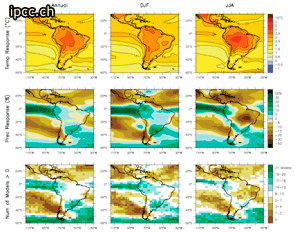By Gavin Roy
A group led by PAGES (Past Global Changes) has ranked human weather observations in South America as the second-highest priority climate data that must be collected, collated, and integrated to understand South America’s climate. Their highest-ranked priority data is tree-ring records, with ice-core samples, glacial variations, and marine sediment records coming after.
 Meteorological observations such as temperature, pressure, and precipitation in South America date back nearly 500 years to 1534 AD, when Spaniards began keeping daily weather logs in present-day Ecuador. Today, as we try to understand how our climate will change in the near future, we look toward records like these to see how our climate has changed in the past. While a great deal of data from South America has already been collected and digitized by IEDRO and other entities, each country still has vast stores containing observations and historic data on old parchments that have not been touched.
Meteorological observations such as temperature, pressure, and precipitation in South America date back nearly 500 years to 1534 AD, when Spaniards began keeping daily weather logs in present-day Ecuador. Today, as we try to understand how our climate will change in the near future, we look toward records like these to see how our climate has changed in the past. While a great deal of data from South America has already been collected and digitized by IEDRO and other entities, each country still has vast stores containing observations and historic data on old parchments that have not been touched.
It is important to retrieve and represent a majority of the existing data to create a full climate record. Once a full or nearly-full record has been compiled, a crucial second step can then be completed: the calibration and homogenization of the climate dataset.
 Instrumentation and observation techniques have evolved over the course of centuries, and thus historical observations must be representatively calibrated, based on their known biases. For example, early mercury thermometers were often produced separately, with little in terms of side-by-side comparisons with similar thermometers for consistency.
Instrumentation and observation techniques have evolved over the course of centuries, and thus historical observations must be representatively calibrated, based on their known biases. For example, early mercury thermometers were often produced separately, with little in terms of side-by-side comparisons with similar thermometers for consistency.
Once the climate data is calibrated to remove instrumental biases and human error, it should be spatially weighted. This means that each site of data collection in South America, when considered as a single point, must be appropriately represented based on its proximity to data collection sites. For example, if there are ten historical data collection sites in Ecuador but only one in Guyana (roughly the same size as Ecuador), the data from Ecuador cannot have ten times more influence on the overall climate records as the data from Guyana simply because Ecuador had more data. This technique for ensuring that the data is properly represented based on geographical proximity is called spatial homogenization. The final implementation of this technique is what the South America focus group of PAGES hopes to see happen in the near future.
The most important thing that can be done to advance this project at present is the ongoing rescue and digitization of historic climate data from South America. IEDRO hopes to continue playing a front-and-center role in its success.
References
“LOTRED-SA – Long-Term climate Reconstruction and Dynamics of (southern) South America: A collaborative, high-resolution multi-proxy approach.” PAGES. 12 January 2011. Web. 14 December 2011.

Comments are closed.